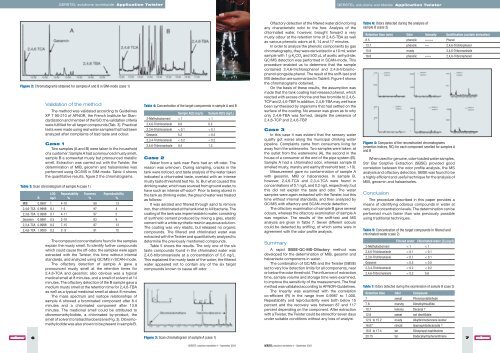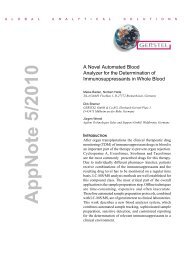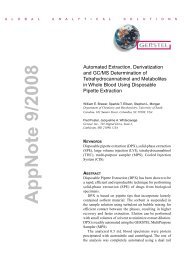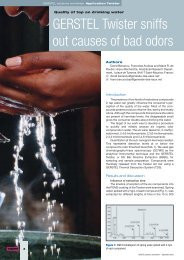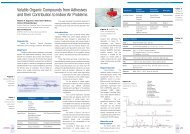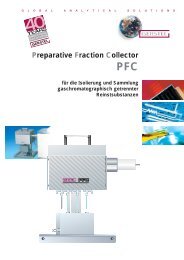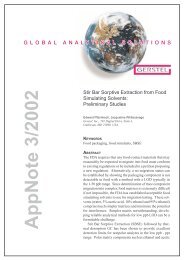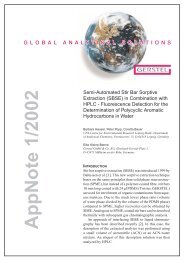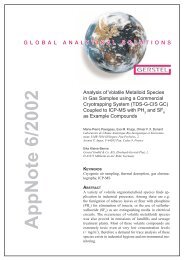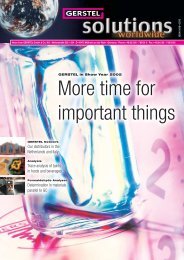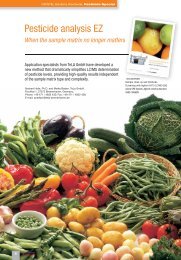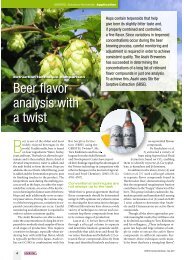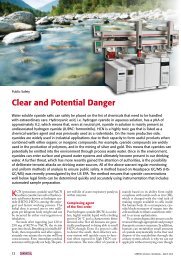GERSTEL Solution no 4
GERSTEL Solution no 4
GERSTEL Solution no 4
You also want an ePaper? Increase the reach of your titles
YUMPU automatically turns print PDFs into web optimized ePapers that Google loves.
<strong>GERSTEL</strong> solutions worldwide Application Twister<br />
<strong>GERSTEL</strong> solutions worldwide Application Twister<br />
Figure 2: Chromatograms obtained for samples A and B in SIM-mode (case 1)<br />
6<br />
Validation of the method<br />
The method was validated according to Guidelines<br />
XP T 90-210 of AFNOR, the French Institute for Standardization<br />
and member of the ISO; the validation criteria<br />
were fulfilled for all target compounds (Tab. 3). Practical<br />
tests were made using real water samples that had been<br />
analyzed after complaints of bad taste and odour.<br />
Case 1<br />
Two samples (A and B) were taken in the household<br />
of a customer: Sample A had a pro<strong>no</strong>unced musty smell,<br />
sample B a somewhat musty but pro<strong>no</strong>unced metallic<br />
smell. Extraction was carried out with the Twister, the<br />
determination of MIB, geosmin and haloanisoles was<br />
performed using GC/MS in SIM-mode. Table 4 shows<br />
the quantitative results, figure 2 the chromatograms.<br />
Table 3: Scan chromatogram of sample A (case 1)<br />
LOQ Repeatability Trueness Reproducibility<br />
R ng/L % % %<br />
MIB 0.9987 1 4-10 89 13<br />
2,4,6-TCA 0.9998 O.1 1-5 97 4<br />
2,3,6-TCA 0.9998 0.1 4-11 97 5<br />
Geosmin 0.9991 0.5 2-10 83 9<br />
2,3,4-TCA 0.9998 0.2 7-15 87 13<br />
2,4,6-TCA 1.0000 0.2 2- 9 91 15<br />
The compound concentrations found in the samples<br />
explain the musty smell. To identify further compounds<br />
which could cause the off-odor, the samples were again<br />
extracted with the Twister, this time without internal<br />
standards, and analyzed using GC/MS in SCAN-mode.<br />
The olfactory detection of sample A gave a<br />
pro<strong>no</strong>unced musty smell at the retention times for<br />
2,4,6-TCA and geosmin; also obvious was a typical<br />
medical smell at 8 minutes, and a smell of solvent at 14<br />
minutes. The olfactory detection of the B sample gave a<br />
medium musty smell at the retention time for 2,4,6-TBA<br />
as well as a typical medicinal smell at about 8 minutes.<br />
The mass spectrum and isotope relationships of<br />
sample A showed a brominated component after 8.4<br />
minutes and a chlorinated component after 13.9<br />
minutes. The medicinal smell could be attributed to<br />
dibromomethyliodide, a chlorinated by-product, the<br />
smell of solvent to tetrachlorobenzene (Fig. 3). Dibromomethyliodide<br />
was also shown to be present in sample B.<br />
Table 4: Concentration of the target components in sample A and B<br />
Sample A[C] (ng/L)<br />
2-Methylisoborneol < 1 < 1<br />
2,4,6-Trichloranisole 8.9 0.2<br />
2,3,6-Trichloranisole < 0.1 < 0.1<br />
Geosmin 5.2 < 0.5<br />
2,3,4-Trichloranisole < 0.2 < 0.2<br />
2,4,6-Tribromanisole 0.4 1.3<br />
Case 2<br />
Water from a tank near Paris had an off-odor. The<br />
reason was unk<strong>no</strong>wn. During sampling, cracks in the<br />
tank were <strong>no</strong>ticed, and taste analysis of the water taken<br />
indicated a chlorinated taste, overlaid with an intense<br />
musty taste (threshold test No. 5). But what caused this<br />
drinking water, which was sourced from ground water, to<br />
have such an intense off-odor? Prior to being stored in<br />
the tank as drinking water, the ground water was treated<br />
as follows:<br />
It was aerated and filtered through sand to remove<br />
iron, then chlorinated at the tank inlet to kill bacteria. The<br />
coating of the tank was impermeable to water, consisting<br />
of synthetic cement produced by mixing a grey, elastic<br />
cement with a white synthetic resin in aqueous solution.<br />
The coating was very elastic, but released <strong>no</strong> organic<br />
compounds. The filtered and chlorinated water was<br />
extracted with the Twister and quantitatively analyzed to<br />
determine the previously mentioned compounds.<br />
Table 5 shows the results. The only one of the six<br />
taste compounds found in the chlorinated water was<br />
2,4,6-tribromoanisole at a concentration of 5.6 ng/L.<br />
This explained the musty taste of the water; the filtered<br />
water appeared <strong>no</strong>t to contain any of the six target<br />
compounds k<strong>no</strong>wn to cause off-odor.<br />
Figure 3: Scan chromatogram of sample A (case 1)<br />
Sample B[C] (ng/L)<br />
Olfactory detection of the filtered water did <strong>no</strong>t bring<br />
any characteristic odor to the fore. Analysis of the<br />
chlorinated water, however, brought forward a very<br />
musty odour at the retention time of 2,4,6-TBA as well<br />
as various phe<strong>no</strong>lic odors at 8, 14 and 17 minutes.<br />
In order to analyze the phe<strong>no</strong>lic components by gas<br />
chromatography, they were derivatized in a 10 mL water<br />
sample with 1 g K 2<br />
CO 3<br />
and 500 µL of acetic anhydride;<br />
GC/MS detection was performed in SCAN-mode. This<br />
procedure enabled us to determine that the sample<br />
contained 2,4,6-trichlorophe<strong>no</strong>l and 2,4,6-tribromophe<strong>no</strong>l<br />
alongside phe<strong>no</strong>l. The result of the sniff-test and<br />
MS detection are summarized in Table 6. Figure 4 shows<br />
the chromatograms obtained.<br />
On the basis of these results, the assumption was<br />
made that the tank coating had released phe<strong>no</strong>l, which<br />
reacted with excess chlorine and free bromide to 2,4,6-<br />
TCP and 2,4,6-TBP. In addition, 2,4,6-TBA may well have<br />
been synthesized by organisms that had settled on the<br />
surface of the coating. No answer was given as to why<br />
only 2,4,6-TBA was formed, despite the presence of<br />
2,4,6-TCP and 2,4,6-TBP.<br />
Case 3<br />
In this case it was evident that the sensory water<br />
quality got worse along the municipal drinking water<br />
pipeline. Complaints came from consumers living far<br />
away from the waterworks. Two samples were taken: at<br />
the outlet from the waterworks (A), the second in the<br />
house of a consumer at the end of the pipe system (B).<br />
Sample A had a chlorinated odor, whereas sample B<br />
smelled musty, marshy and earthy (threshold test: > 10).<br />
Measurement gave <strong>no</strong> contamination of sample A<br />
with geosmin, MIB or haloanisoles. In sample B,<br />
however, 2,4,6-TCA and 2,3,4-TCA were found in<br />
concentrations of 0.1 ng/L and 0.2 ng/L respectively; but<br />
this did <strong>no</strong>t explain the taste and odor. The water<br />
samples were again extracted with the Twister, but this<br />
time without internal standards, and then analyzed by<br />
GC/MS with olfactory and SCAN-mode detection.<br />
The olfactory examination of sample B gave several<br />
odours, whereas the olfactory examination of sample A<br />
was negative. The results of the sniff-test and MS<br />
analysis are given in Table 7. Seven different odours<br />
could be detected by sniffing, of which some were in<br />
agreement with the odor profile analysis.<br />
Summary<br />
A rapid SBSE-GC-MS-Olfactory method was<br />
developed for the determination of MIB, geosmin and<br />
haloanisole components in water.<br />
The combination of GC/MS and the Twister (SBSE)<br />
led to very low detection limits for all components, near<br />
or below the odor threshold. The influence of extraction<br />
time, sample volume and storage time were examined,<br />
to improve the sensitivity of the measurement. The final<br />
method was validated according to AFNOR-Guidelines.<br />
The linearity was examined with the correlation<br />
co-efficient (R) in the range from 0.9987 to 1.000.<br />
Repeatability and reproducibility were both below 15<br />
percent and the recovery was between 87 and 117<br />
percent depending on the component. After extraction<br />
with a Twister, the Twister could be stored for seven days<br />
under suitable conditions without any loss of analyte.<br />
Table 6: Odors detected during the analysis of<br />
sample B (case 2)<br />
Retention time (min) Odor Intensity Qualification (acetate derivative)<br />
8.5 phe<strong>no</strong>lic ++++ Phe<strong>no</strong>l<br />
13.7 phe<strong>no</strong>lic ++ 2,4,6-Trichlorphe<strong>no</strong>l<br />
15.9 musty 2,4,6-Tribromanisole<br />
16.8 phe<strong>no</strong>lic +++ 2,4,6-Tribromphe<strong>no</strong>l<br />
Figure 4: Comparion of the reconstructed chromatograms<br />
(retention indices, RIC) for each component smelled for samples A<br />
and B<br />
When used for genuine, odor-loaded water samples,<br />
Stir Bar Sorptive Extraction (SBSE) provided good<br />
correlation between the odor profile analysis, the MS<br />
analysis and olfactory detection. SBSE was found to be<br />
a highly efficient and useful technique for the analysis of<br />
MIB, geosmin and haloanisoles.<br />
Conclusion<br />
The procedure described in this paper provides a<br />
means of identifying odorous compounds in water at<br />
very low concentration levels. The determination can be<br />
performed much faster than was previously possible<br />
using traditional techniques.<br />
Table 5: Concentration of the target compounds in filtered and<br />
chlorinated water (case 2)<br />
Filtered water Chlorinated water [C] (ng/L)<br />
2-Methylisoborneol < 1 < 1<br />
2,4,6-Trichloranisole < 0.1 < 0.1<br />
2,3,6-Trichloranisole < 0.1 < 0.1<br />
Geosmin < 0.5 < 0.5<br />
2,3,4-Trichloranisole < 0.2 < 0.2<br />
2,4,6-Tribromanisole < 0.2 5.6<br />
Table 7: Odors detected during the examination of sample B (case 3)<br />
Retention time Odor Compound<br />
7 sweat Phenylacetaldehyde<br />
7.8 marshy Dimethyltrisulfide<br />
10.7 lemony Decanal ?<br />
12.8 sweat <strong>no</strong>t identifiable<br />
12.9 to 15.2 musty Alkylbromobenzene isomer<br />
16.07 rancid Isopropyldodeca<strong>no</strong>ate ?<br />
16.8 to 17.4 tar Diisopropyl naphthalene<br />
20.15 tar Dodecahydrophenanthrene<br />
7<br />
<strong>GERSTEL</strong> solutions worldwide 4 – September 2003<br />
<strong>GERSTEL</strong> solutions worldwide 4 – September 2003


